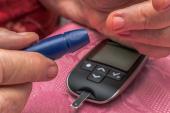USPSTF Lowers Screening Age for Diabetes, Prediabetes to 35 for Overweight Adults
Experts say implementation will require virtual options and culturally tailored care to address the needs of younger patients.

Beginning at age 35 and continuing through age 70, adults who are overweight or obese should be screened for diabetes and prediabetes, according to new recommendations from the US Preventive Services Task Force (USPSTF). The change lowers the age previously recommended for screening by 5 years.
Michael J. Barry, MD (Massachusetts General Hospital, Boston), vice chair of the USPSTF, told TCTMD that given the epidemic of obesity in the United States, the recommendations broaden the screening to include a significant portion of the younger population.
“Obesity and diabetes are becoming more common in younger people, and in fact, the risk of having diabetes jumps up at about age 35 from 1% to about 3%, and is pretty much stable at 3% at ages 40 to 45,” he noted.
Published in JAMA and led by Karina W. Davidson, PhD, (Feinstein Institutes for Medical Research, New York, NY), the USPSTF’s statement also recommends that clinicians “offer or refer patients with prediabetes to effective preventive interventions.” To TCTMD, Barry said focused efforts on finding and treating prediabetes are crucial since roughly a third of those who have it don’t know it.
“We have strong evidence that addressing prediabetes mainly through lifestyle changes, diet and exercise leading to weight loss, can dramatically reduce progression of prediabetes to diabetes,” he added. Though much of the screening is done by primary care physicians, Barry said cardiologists and others should be attuned to the new recommendations. “If someone fits this age and body mass index recommendation, it doesn't matter who screens them as long as they get screened,” he added.
In an accompanying editorial, Edward W. Gregg, PhD (Imperial College London, England), and Tannaz Moin, MD, MBA (University of California, Los Angeles), say young adults “appear to be the group with the most to lose by current levels of diabetes care delivery and the most to gain by attention to the new recommendation.”
Gregg and Moin add that new ideas are needed to address existing barriers to glycemic and cardiovascular risk factor control in younger people, including insecurities involving food, housing, and medication. Also important, they add is modifying preventive intervention programs to ensure that young patients with prediabetes are referred and encouraged to participate.
Echoing that sentiment, Richard W. Grant, MD, MPH (Kaiser Permanente Northern California, Oakland), and colleagues say in a second editorial that while the USPSTF’s recommendations are a good first step, “evidence suggests that younger adults face challenges in adapting to the demands of chronic-disease management.” They advocate for “virtual care, after hours and weekend office hours, and culturally tailored care” to address the population of younger and ethnically diverse adults most likely to be affected by the change in screening.
Evidence Review
The new recommendations are based on an evidence review of 89 studies that included nearly 70,000 patients. The interventions used in those studies were population screening, early risk-factor management in diabetic patients, and preventive interventions in prediabetic patients.
Led by Daniel E. Jonas, MD, MPH (The Ohio State University, Columbus), and published in the same issue of JAMA as the USPSTF’s report and the editorials, the evidence report found only weak evidence of a long-term mortality benefit associated with diabetes screening and limited data on the impact of screening on other health outcomes. Looking at potential harms associated with screening, no clear harms emerged, although those who were diagnosed with diabetes as a result of screening reported some short-term anxiety.
On the basis of five RCTS—including the UK Prospective Diabetes Study (UKPDS), which enrolled adults as young as age 25—intensive glucose control with metformin was associated with less all-cause mortality at 10 years, however, in overweight people with newly diagnosed diabetes compared with diet or other antiglycemic agents (RR 0.64; 95%CI 0.45-0.91). In patients with prediabetes, data from 23 trials supported the role of a variety of lifestyle interventions in reducing the incidence of diabetes in obese or overweight individuals compared with controls (RR 0.78; 95%CI 0.69-0.88). Pooled trial data also support the role of metformin in lowering weight and BMI.
Barry said the USPSTF took an indirect pathway to form their argument for lowering the age recommendation due to the mixed bag of evidence. The argument rests on a combination of the efficacy and accuracy of screening and the greater than 10-year follow-up from UKPDS, which was as long as 20 years in some cases.
“UKPDS is the one trial that has that long follow-up to help make the link between detection of diabetes and improved outcomes,” Barry explained. “It’s important because that's the time horizon that we're considering for people, particularly in their late 30s and 40s, who may be harboring diabetes or prediabetes.”
Changing Demographics and Societal Challenges
As the task force, the evidence report, and the editorials all note, the vast majority of the diabetes screening studies in the literature are in white individuals, elevating the importance of diversifying trials to better reflect the populations in whom diabetes is most prevalent.
In the meantime, Grant and colleagues worry that implementation of the new screening recommendations has the potential to exacerbate disparities in diabetes care in newly diagnosed young Black and Hispanic/Latinx patients.
“Implementing effective and affordable behavioral change programs that meet the needs and schedules of younger adults from diverse backgrounds is an important step and an achievable goal,” they write. “Addressing the factors that contribute to unequal access to healthy foods and opportunities for physical activity is a much greater challenge and will require a higher public health priority and increased funding.”
Barry added that diabetes prevention programs such as those run by YMCAs and other community organizations may be one way of providing accessible services to younger people to support them in necessary lifestyle and behavioral changes.
L.A. McKeown is a Senior Medical Journalist for TCTMD, the Section Editor of CV Team Forum, and Senior Medical…
Read Full BioSources
US Preventive Services Task Force. Screening for prediabetes and type 2 diabetes: US Preventive Services Task Force recommendation statement. JAMA. 2021;326:736-743.
Jonas DE, Crotty K, Yun JDY, et al. Screening for prediabetes and type 2 diabetes: updated evidence report and systematic review for the US Preventive Services Task Force. JAMA. 2021;326:744-760.
Grant RW, Gopalan A, Jaffe MG. Updated USPSTF screening recommendations for diabetes: identification of abnormal glucose metabolism in younger adults. JAMA. 2021;Epub ahead of print.
Gregg EW, Moin, T. New USPSTF recommendations for screening for prediabetes and type 2 diabetes: an opportunity to create national momentum. JAMA. 2021;326:701-703.





Comments